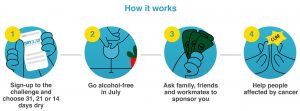New data from the Australian Institute of Health and Welfare (AIHW) has revealed that, despite knowing the dangers and health outcomes associated with excessive drinking, many Australians are still drinking at levels that are putting them at risk.
The AIHW’s Alcohol, Tobacco and Other Drugs data has shown that in 2017-18, one in five Australians consumed alcohol at levels that put them at risk of harm.
These new figures come as new data released by the Australian Bureau of Statistics (ABS) reveals that 14% of Australians report an increase in alcohol consumption during the COVID-19 lockdown.
“The data released today [26 June 2020] shows that nearly 80% of Australians drink and one in five drink at levels that put them at risk of developing alcohol-related chronic conditions,” says Clare Hughes, Chair of Cancer Council’s Nutrition and Physical Activity Committee.
“It also shoed alcohol is the most common drug that people seek help for.
“So, while alcohol is legal and a socially accepted substance, we know that its use creates a significant health, social and economic burden for Australians.”
Ms Hughes warns that alcohol is “linked to increased risk of seven types of cancer”, including bowel cancer, breast cancer and mouth cancer.
“Research has shown that if all Australians stuck to the current alcohol guidelines, we could prevent 30,000 cancer cases over the next 25 years, so there are significant benefits in reducing alcohol consumption in Australia,” she says.
The current National Health and Medical Research Council (NHMRC) alcohol guidelines recommend no more than two standard drinks per day, with at least two alcohol-free days per week.
However, Ms Hughes says that there is still “some risk with any level of alcohol consumption”.
“What many people don’t realise is that any amount of alcohol increases your risk of cancer, so if you do choose to drink, make sure you drink within the guidelines and try to have some alcohol-free days every week,” she says.
So, while alcohol intake may have increased during the COVID-19 lockdown, with Dry July just around the corner, perhaps this is a good time to give your body a break from the booze.

For more information and to register for Dry July, visit: dryjuly.com.









